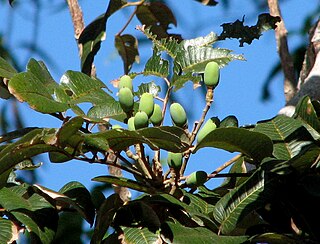
Canarium australianum, commonly known as scrub turpentine, is a species of tree in the family Burseraceae native to Australia and Papua New Guinea. Other common names include mango bark, carrot wood, parsnip wood, Melville Island white beech and brown cudgerie.
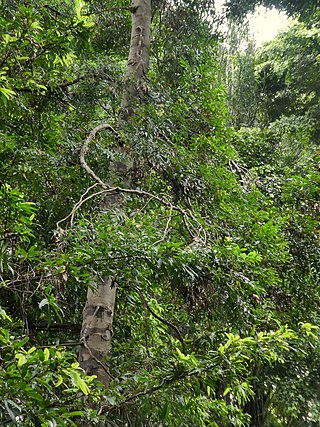
Agathis atropurpurea, commonly known as the blue kauri, and occasionally as the black kauri or purple kauri, is a species of conifer in the very ancient plant family Araucariaceae. The family was distributed almost worldwide during the Jurassic and Cretaceous periods, but is now mostly confined to the Southern Hemisphere. This species is endemic to a small part of northeastern Queensland, Australia.

Euroschinus falcatus is a large tree in the mango and cashew family Anacardiaceae, found along almost the entire east coast of Australia from Cape York Peninsula to Jervis Bay. Common names include blush cudgerie and maiden's blush.
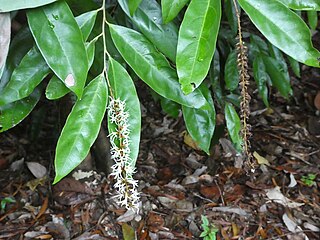
Neostrearia is a monotypic genus - i.e. a genus containing only one species - of plants in the witch-hazel family Hamamelidaceae. It is the second described of three monotypic Australian genera in this family, the others being Ostrearia and Noahdendron. It is most closely related to these genera, as well as Trichocladus from southern Africa and Dicoryphe from Madagascar, and together these five genera form a distinct clade within Hamamelidaceae.
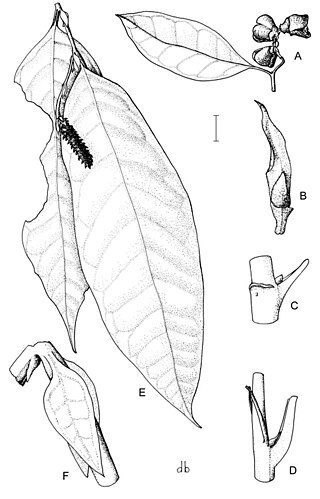
Ostrearia is a monotypic genus - i.e. a genus containing only one species - of plants in the witch-hazel family Hamamelidaceae. It is the first described of three monotypic Australian genera in this family, the others being Neostrearia and Noahdendron. It is most closely related to these genera, as well as Trichocladus from southern Africa and Dicoryphe from Madagascar, and together these five genera form a distinct clade within Hamamelidaceae.

Noadendron is a monotypic genus - i.e. a genus containing only one species - of plants in the witch-hazel family Hamamelidaceae. It is the third described of three monotypic Australian genera in this family, the others being Ostrearia and Neostrearia. It is most closely related to these genera, as well as Trichocladus from southern Africa and Dicoryphe from Madagascar, and together these five genera form a distinct clade within Hamamelidaceae.

Acalypha lyonsii, commonly known as Lyon's acalypha is a shrub in the spurge family Euphorbiaceae that is only found in the vicinity of Cairns, Queensland, Australia.

Hypserpa laurina is a slender twining climber in the plant family Menispermaceae. It is native to New Guinea and northeastern Queensland in Australia.
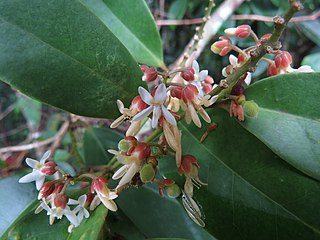
Xanthophyllum octandrum, commonly known as Macintyre's boxwood, false jitta, yellow boxwood or sovereignwood, is a slow-growing tree in the milkwort family Polygalaceae which has the potential to reach thousands of years of age. It is endemic to coastal northeastern Queensland, Australia.

Alstonia muelleriana is a tree in the dogbane family Apocynaceae which is native to southern Papua New Guinea and northeastern Queensland.

Alyxia oblongata, commonly known as the chain fruit, prickly lixy, or prickly Alyxia, is a plant in the dogbane family Apocynaceae endemic to a small part of northeastern Queensland.
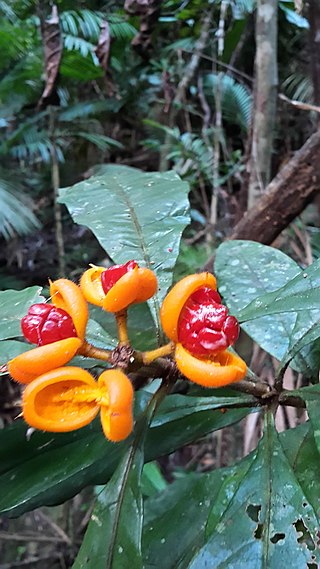
Pittosporum rubiginosum, commonly known as hairy red pittosporum, is an evergreen shrub in the family Pittosporaceae which is endemic to northeastern Queensland, Australia. It was first described in 1840.

Fagraea cambagei, commonly known as porcelain fruit, pink jitta, or yellowheart, is a plant in the family Gentianaceae which is endemic to rainforested parts of coastal northeast Queensland, Australia.

Actephila foetida is a plant in the family Phyllanthaceae that is found only in a very restricted range within the Wet Tropics bioregion of Queensland, Australia. It was first described in 1927.

Buchanania mangoides, commonly known as plum tree, is a plant in the mango and cashew family Anacardiaceae native to Queensland, Australia. It was first described in 1869.
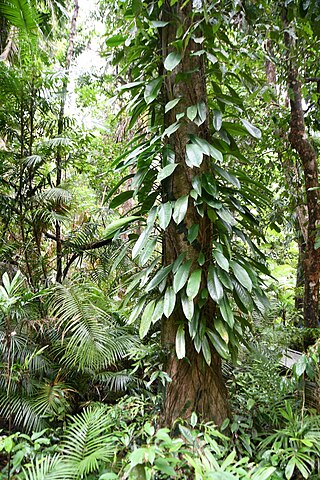
Rhaphidophora australasica, commonly known as needle berry, is a plant in the arum family Araceae that is only found in the Wet Tropics bioregion of northeastern Queensland, Australia. It is a semi-epiphytic, robust, herbaceous, root climber reaching about 30 m (98 ft) tall. The dark green leaves are oblanceolate to elliptic and measure up to 40 cm (16 in) long by 14 cm (5.5 in) wide. The inflorescence is a spadix about 6–8 cm (2.4–3.1 in) long, enclosed in a spathe about 13 cm (5.1 in) long.

Debregeasia australis, commonly known as china grass or native ramie, is a plant in the nettle family Urticaceae endemic to Queensland, Australia.

Peperomia hunteriana is a plant in the pepper family Piperaceae found only in the Wet Tropics bioregion of Queensland, Australia.
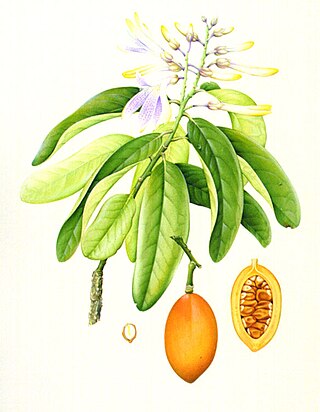
Xanthophyllum fragrans, commonly known as fragrant boxwood, is an evergreen plant in the family Polygalaceae found only in the Wet Tropics bioregion of Queensland, Australia.

Peperomia enervis is a plant in the pepper family Piperaceae found only in rainforests of northeast Queensland near the cities of Cairns and Mackay. It was first described in 1891.
























